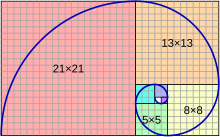In mathematics, the Fibonacci numbers, commonly denoted Fn form a sequence, called the Fibonacci sequence, such that each number is the sum of the two preceding ones, starting from 0 and 1. That is,[1]
{\displaystyle F_{0}=0,\quad F_{1}=1,}
and
{\displaystyle F_{n}=F_{n-1}+F_{n-2},}
for n > 1.
One has F2 = 1. In some books, and particularly in old ones, F0, the "0" is omitted, and the Fibonacci sequence starts with F1 = F2 = 1.[2][3] The beginning of the sequence is thus:
{\displaystyle (0,)\;1,\;1,\;2,\;3,\;5,\;8,\;13,\;21,\;34,\;55,\;89,\;144,\;\ldots } [4]
[4]

The Fibonacci spiral: an approximation of the golden spiralcreated by drawing circular arcsconnecting the opposite corners of squares in the Fibonacci tiling;[5] this one uses squares of sizes 1, 1, 2, 3, 5, 8, 13 and 21.
Fibonacci numbers are strongly related to the golden ratio: Binet's formula expresses the nth Fibonacci number in terms of n and the golden ratio, and implies that the ratio of two consecutive Fibonacci numbers tends to the golden ratio as n increases.
Fibonacci numbers are named after Italian mathematician Leonardo of Pisa, later known as Fibonacci. They appear to have first arisen as early as 200 BC in work by Pingala on enumerating possible patterns of poetry formed from syllables of two lengths. In his 1202 book Liber Abaci, Fibonacci introduced the sequence to Western European mathematics,[6] although the sequence had been described earlier in Indian mathematics.[7] [9]
[9]
Fibonacci numbers appear unexpectedly often in mathematics, so much so that there is an entire journal dedicated to their study, the Fibonacci Quarterly. Applications of Fibonacci numbers include computer algorithms such as the Fibonacci search technique and the Fibonacci heap data structure, and graphs called Fibonacci cubes used for interconnecting parallel and distributed systems.
They also appear in biological settings, such as branching in trees, the arrangement of leaves on a stem, the fruit sprouts of a pineapple, the flowering of an artichoke, an uncurling fern and the arrangement of a pine cone's bracts.
For a fun video on the Fibonacci sequence watch https://www.youtube.com/watch?v=wTlw7fNcO-0.
This cache is part of a sequence of 9 caches. Each cache has a letter attached to it. Collect all of the letters and use that to find the final (GC8BXMH).